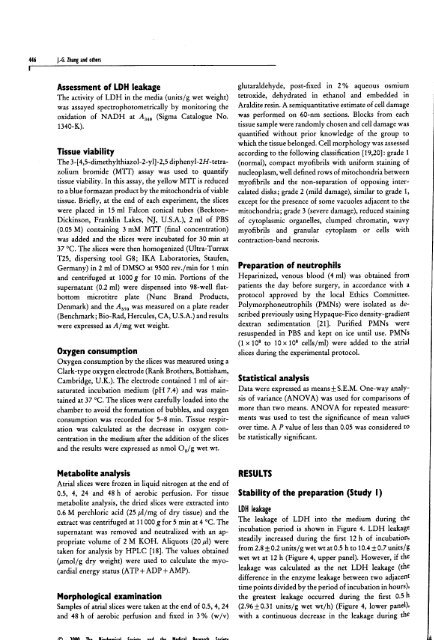ischaemic preconditioning of the human heart. - Leicester Research ...
ischaemic preconditioning of the human heart. - Leicester Research ...
ischaemic preconditioning of the human heart. - Leicester Research ...
You also want an ePaper? Increase the reach of your titles
YUMPU automatically turns print PDFs into web optimized ePapers that Google loves.
446 J.<br />
-G. Zhang<br />
and o<strong>the</strong>rs<br />
Assessment <strong>of</strong> LDH leakage<br />
The activity <strong>of</strong> LDH in <strong>the</strong> media (units/g wet weight)<br />
was assayed spectrophotometrically by monitoring <strong>the</strong><br />
oxidation <strong>of</strong> NADH at A,,,, (Sigma Catalogue No.<br />
1340-K).<br />
Tissue viability<br />
The 3-[4,5-dimethylthiazol-2-yl]-2,5 diphenyl-2H-tetra-<br />
zolium bromide (MTT) assay was used to quantify<br />
tissue viability. In this assay, <strong>the</strong> yellow MTT is reduced<br />
to a blue formazan product by <strong>the</strong> mitochondria <strong>of</strong> viable<br />
tissue. Briefly, at <strong>the</strong> end <strong>of</strong> each experiment, <strong>the</strong> slices<br />
were placed in 15 ml Falcon conical tubes (Beckton-<br />
Dickinson, Franklin Lakes, NJ, U. S. A. ), 2 ml <strong>of</strong> PBS<br />
(0.05 M) containing 3 mM MTT (final concentration)<br />
was added and <strong>the</strong> slices were incubated for 30 min at<br />
37 "C. The slices were <strong>the</strong>n homogenized (Ultra-Turrax<br />
T25, dispersing tool G8; IKA Laboratories, Staufen,<br />
Germany) in 2 ml <strong>of</strong> DMSO at 9500 rev. /min for 1 min<br />
and centrifuged at 1000 g for 10 min. Portions <strong>of</strong> <strong>the</strong><br />
supernatant (0.2 ml) were dispensed into 98-well flat-<br />
bottom microtitre plate (Nunc Brand Products,<br />
Denmark) and <strong>the</strong> A,,,, was measured on a plate reader<br />
(Benchmark; Bio-Rad, Hercules, CA, U. S. A. ) and results<br />
were expressed as A/mg wet weight.<br />
Oxygen consumption<br />
Oxygen consumption by <strong>the</strong> slices was measured using a<br />
Clark-type oxygen electrode (Rank Bro<strong>the</strong>rs, Bottisham,<br />
Cambridge, U. K. ). The electrode contained 1 ml <strong>of</strong> air-<br />
saturated incubation medium (pH 7.4) and was main-<br />
tained at 37 'C. The slices were carefully loaded into <strong>the</strong><br />
chamber to avoid <strong>the</strong> formation <strong>of</strong> bubbles, and oxygen<br />
consumption was recorded for 5-8 min. Tissue respir-<br />
ation was calculated as <strong>the</strong> decrease in oxygen con-<br />
centration in <strong>the</strong> medium after <strong>the</strong> addition <strong>of</strong> <strong>the</strong> slices<br />
and <strong>the</strong> results were expressed as nmol 0, /g wet wt.<br />
Metabolite analysis<br />
Atrial slices were frozen in liquid nitrogen at <strong>the</strong> end <strong>of</strong><br />
0.5,4,24 and 48 h <strong>of</strong> aerobic perfusion. For tissue<br />
metabolite analysis, <strong>the</strong> dried slices were extracted into<br />
0.6 M perchloric acid (25, ul/mg <strong>of</strong> dry tissue) and <strong>the</strong><br />
extract was centrifuged at I 1000 g for 5 min at 4 "C. The<br />
supernatant was removed and neutralized with an ap-<br />
propriate volume <strong>of</strong> 2M KOH. Aliquots (20, ul) were<br />
taken for analysis by HPLC [18]. The values obtained<br />
(umol/g dry weight) were used to calculate <strong>the</strong> myo-<br />
cardial energy status (ATP + ADP + AMP).<br />
Morphological examination<br />
Samples<br />
<strong>of</strong> atrial slices were taken at <strong>the</strong> end <strong>of</strong> 0.5,4,24<br />
and 48 h <strong>of</strong> aerobic perfusion and fixed in 3% (w/v)<br />
glutaraldehyde, post-fixed in 2% aqueous osmium<br />
tetroxide, dehydrated in ethanol and embedded in<br />
Araldite resin. A serniquantitative estimate <strong>of</strong> cell damage<br />
was performed on 60-nm sections. Blocks from each<br />
tissue sample were randomly chosen and cell damage<br />
was<br />
quantified without prior knowledge <strong>of</strong> <strong>the</strong> group to<br />
which <strong>the</strong> tissue belonged. Cell morphology was assessed<br />
according to <strong>the</strong> following classification [19,20]: grade 1<br />
(normal), compact my<strong>of</strong>ibrils with uniform staining <strong>of</strong><br />
nucleoplasm, well defined rows <strong>of</strong> mitochondria between<br />
my<strong>of</strong>ibrils and <strong>the</strong> non-separation <strong>of</strong> opposing inter-<br />
calated disks; grade 2 (mild damage),<br />
similar to grade 1,<br />
except for <strong>the</strong> presence <strong>of</strong> some vacuoles adjacent to <strong>the</strong><br />
mitochondria; grade 3 (severe damage), reduced staining<br />
<strong>of</strong> cytoplasmic organelles, clumped chromatin, wavy<br />
my<strong>of</strong>ibrils and granular cytoplasm or cells with<br />
contraction-band necrosis.<br />
Preparation <strong>of</strong> neutrophils<br />
Heparinized, venous blood (4 ml) was obtained from<br />
patients <strong>the</strong> day before surgery, in accordance with a<br />
protocol approved by <strong>the</strong> local Ethics Committee.<br />
Polymorphoneutrophils (PMNs) were isolated as de-<br />
scribed previously using Hypaque-Fico density-gradient<br />
dextran sedimentation [21]. Purified PMNs were<br />
resuspended in PBS and kept on ice until use. PMNs<br />
(1 x 106 to 10 x 10' cells/ml) were added to <strong>the</strong> atrial<br />
slices during <strong>the</strong> experimental protocol.<br />
Statistical analysis<br />
Data were expressed as means+ S. E. M. One-way analy-<br />
sis <strong>of</strong> variance (ANOVA) was used for comparisons <strong>of</strong><br />
more than two means. ANOVA for repeated measure-<br />
ments was used to test <strong>the</strong> significance <strong>of</strong> mean values<br />
over time. AP value <strong>of</strong> less than 0.05 was considered to<br />
be statistically significant.<br />
RESULTS<br />
Stability <strong>of</strong> <strong>the</strong> preparation (Study 1)<br />
LDH leakage<br />
The leakage <strong>of</strong> LDH into <strong>the</strong> medium during <strong>the</strong><br />
incubation period is shown in Figure 4. LDH leakage<br />
steadily increased during <strong>the</strong> first 12 h <strong>of</strong> incubation,<br />
from 2.8 + 0.2 units/g wet wt at 0.5 h to 10.4 + 0.7 units/9<br />
wet wt at 12 h (Figure 4, upper panel). However, if <strong>the</strong><br />
leakage was calculated as <strong>the</strong> net LDH leakage (<strong>the</strong><br />
difference in <strong>the</strong> enzyme leakage between two adjacent<br />
time points divided by <strong>the</strong> period <strong>of</strong> incubation in hours),<br />
<strong>the</strong> greatest leakage occurred during <strong>the</strong> first 0.5 h<br />
(2.96+0.31 units/g wet wt/h) (Figure 4, lower panel),<br />
with a continuous decrease in <strong>the</strong> leakage during <strong>the</strong>














